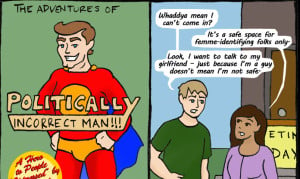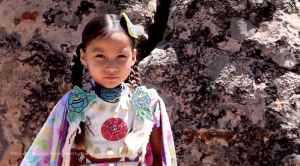Originally published on Romper and republished with their permission.
Just over two months ago, I found out I was twenty weeks pregnant. A few minutes later, I found out I was pregnant with who would likely be a little girl. It was a moment as thrilling as it was horrifying.
I mean, I could relate to a girl. I’ve been one for a quarter of a century or so. But I couldn’t shake the feeling that her life would most likely be more difficult by virtue of her being a girl.
Although I would want to take strides to raise a fat-positive kid (and an overall body-positive kid) regardless of their assigned gender, the constant body negativity inflicted on women and feminine people in this world made the goal feel all the more pressing.
If girls are constantly told, by society as a whole, that they are not pretty enough, not thin enough, not good enough, then all I can do is my best to combat those messages within the household.
So I’ve been spending a lot of time thinking of what small actions would’ve made my own upbringing a safer space for my fat body and contributed to a better understanding of the importance and beauty of body diversity overall.
I know deep down that socioculturally ingrained fat biases largely remain the norm, while fat acceptance (let alone fat positivity) remains a principally esoteric notion.
As a result, there’s little I can do to prevent my kid from encountering fat-antagonism as soon as she’s old enough to go to school, or watch television, or pick up a mainstream magazine.
Regardless of the size or shape my daughter herself ends up being, however, there are some small things I can do as a parent that’ll hopefully help her grow into a fat-positive person – a quality that I believe will benefit not only her own body image but the way she perceives and treats the bodies of others.
1. Display Fat-Positive Artwork at Home
I don’t recall encountering fat-positive (or even fat-neutral) artwork until my late teens.
On a summer holiday to visit relatives in Medellin, Colombia, we took a stroll through a museum filled with sculptures and paintings by Fernando Botero. Botero is known principally for his depictions of fat individuals, who he believes to be especially beautiful.
To see bodies like mine in a context free from shaming was nothing short of flooring.
Prior to that moment, most artwork I’d come across in history class, at other museums, in magazines, and at home depicted rather conventionally attractive humans. They were often thin, white, cisgender, and able.
But it was the thinness that most made me, personally, feel othered. Why wasn’t anyone painting my body type? Why weren’t women like me worthy of the glossies?
Because most bodies we see in our mainstream media intake err on the side of thinness, I’m hoping for my household to be a little different. Although I want to display artwork of a diverse range of body types, I will likely focus on fat figures.
Repeated exposure to positive imagery of fat bodies is one way that I believe we can normalize larger body types – so that folks of all sizes stray from the belief that fatness is inherently ugly and intolerable.
2. Avoid Euphemisms
There are plenty of terms people use to avoid saying the word fat for their own reasons. It could be because they were fat-shamed when they were younger and the word just doesn’t feel like an identity they can call home.
Some of the words that also denote fatness are: husky, curvy, plus size, or queen-size. But it’s my firm opinion that when we avoid a word completely, we add to the taboo and shame surrounding it.
If I want my kid to believe that there’s nothing wrong with the word fat – nor with having fat, or being a fat person – then I must introduce her to the word itself, and frame it as positively or neutrally as possible.
As a fat parent-to-be, I plan to openly utilize the word fat when describing my body type. It’s something I already practice, and something I’ll continue doing. It’s also a word I apply to fellow self-identified fats who I know are comfortable with these three small letters.
Although I’ll likely discourage my child from calling someone fat if they have not specified their comfort levels with the term, I hope that identifying as such myself will contribute to the recognition that fat is not something to be feared, hated, or mistreated when encountered in oneself or in others.
3. Introduce Her to Fat-Positive Role Models
When I was a little girl, there were few visibly fat, tangibly empowered role models for me to turn to in a macro kind of way. I wouldn’t learn about Beth Ditto until my teens, and proponents of fat-acceptance principals wouldn’t hit my radar until my early twenties.
In a few short years, however, there are more unapologetically fat people than ever before making waves online and otherwise – women and femmes, in particular – who are refusing to conform to aspirational tropes of beauty.
I want my kid to know about as many of them as possible. So I plan on showing her the images and words of radical fat bloggers and voices within the community who have long inspired me.
From Stephanie Yeboah of Nerd About Town, to writer and activist Lesley Kinzel, to Ariel Woodson and KC Slack of Bad Fat Broads, she will know that to be fat does not have to mean you suddenly becomes invisible or dismissible.
No matter her own body type, I want my daughter to realize – ideally, from a very young age – that being fat never has to equate to giving up on anything you want to do, or be, or say, or feel.
Because I know, beyond a doubt, that much of society will try to teach her otherwise.
4. Refrain from Connoting Body Types (And Food) with Morals
There’s a super uncomfortable thing many people are known to do when discussing body types, or food: many often bring in morality-fueled words like good and bad into the picture.
For example, a thin body is a “good body,” while a fat one is a “bad body.” Eating a cupcake means someone has been “bad that day,” while eating a kale salad means they have been “very good.”
When we do this, we arguably contribute to the belief that fatness is a sign of inferiority, while thinness is a sign of superiority. I don’t doubt that the perpetuation of such constructs aids the vilification of fat people overall, including on our television and in our movies.
I never want my kid to feel ashamed or less than because of the size of her body, no matter what size that may be.
But I also never want her to see a fat person and instinctually assign them labels like “bad” or “unhealthy” or “disgusting” or a “failure.” Therefore, food will never be framed with terms that imply morality, much like body types won’t be, either.
5. Frame Fitness as Being About Health, Not Size
Too often, conversations about fitness and body types seem to go hand in hand.
I vividly remember an elementary school gym teacher encouraging me to run a few laps around the soccer feel so that I could work on losing my belly – rather than, you know, so I could grow fitter and stronger.
I wouldn’t want to devalue the mental and physical benefits of fitness in my household, but I also want to be very careful not to reinforce toxic beliefs about exercise along the way.
Since much of workout-related imagery utilizes individuals of one body type – failing to recognize that humans of all sizes are capable of participating in yoga or sports – I’ll be sure my kid sees photos of fat people killing the workout game.
But, overall, I also want to avoid ever associating exercise with a number on a scale.
It’s perfectly possible to encourage fitness without encouraging body negativity. All you have to do is leave weight out of it, and focus on the fun that going on a walk, or taking a run, or visiting your favorite dance class can yield.
6. Introduce the Notion of Health at Every Size
Too often, fatness can be disregarded by the medical community as well as individuals in the day-to-day as “unhealthy.”
Even more often, the label is thrown onto fat people by folks with no understanding of the inner-workings of said fat people’s bodies.
Because fat of any kind was framed as an inherent negative (rather than a thing we all need to survive), I spent a lot of time as a kid legitimately believing that I had to lose weight unless I wanted to die at 25. I don’t want the same fate for my own child.
I plan on introducing her to the research behind the notion of Health at Every Size, and the radical work done by medical professionals like Dr. Linda Bacon and Michelle of The Fat Nutritionist.
I want to make sure she knows that BMI (the scale that determines whether you are “overweight” or “obese”) has repeatedly proven to mean nothing of substance at all.
I need her to know that, even if she is fat, the number on the scale should never be reason for doctors to dismiss her symptoms, misdiagnose her illnesses, or otherwise mistreat her.
But more than all this, I also want to make sure she’s aware of the simple fact that a person’s health should never equate to how much tolerance they deserve.
Whether someone is clinically healthy or unhealthy, they are still a human being. Thinking and behaving in any way that contradicts this is ableist and a pure sign of unnecessary prejudice.
7. Refuse to Let Fat-Shaming Slide
To be honest, this one should apply to body shaming of any kind.
But one type of body shaming arguably most prevalent in this world of ours is fat-shaming.
Whether it’s in the form of a relatively innocent comment like “I feel so fat in this dress” or “This isn’t the right fit” or a supporter of a certain presidential candidate laughing about said candidate’s stance on “disgusting,” “Miss Piggy”-like fat women, or a joke that centers fatness as something condemnable and laughable, it’s crucial to say something.
I just don’t want my kid learning that any kind of behavior that suggests someone’s body type is worthy of ridicule is okay.
When it comes to fat bodies, the stigma is everywhere. It’s impossible to control all of it. But if ever someone in our vicinity mistreats fat bodies, you can bet that I’m going to try my damnedest to speak up.
I’ll try to ask them what it is, exactly, about a person’s body type that’s so funny or so offensive. I’ll ask them how the sight of a fat woman in short shorts or in a bikini is causing them harm. I’ll tell them that they are being prejudicial.
I’ll remind them that the things they are saying imply that the fat people they might know and care about (myself included, whenever relevant) are somehow “less than.”
And I’ll always try to have a conversation with my kid about it after, so she knows why being mindful of language is so important.
8. Never Use ‘Fat’ as an Insult
It probably goes without saying at this point, but something I would never do in general – let alone around a child whose brain is like a sponge – is correlate the word fat to any derogatory or insulting turn of phrase out there.
I won’t use it as a synonym for “cruel” or “unattractive” or “lazy” or “useless” or “deplorable.” I won’t use it when referring to a plus-size person I genuinely dislike.
Far too often, I hear people around me target a cruel or horrid person for their weight rather than the words they are using, or the problematic things they are doing. This links fatness to pure negativity, and it needs to stop.
I hope my kid learns that fat is just that: a three-letter word with the literal definition of “a natural oily substance occurring in animal bodies.”
I hope she learns that it can be beautiful and wonderful and that all sorts of magical people can have fat, or be fat.
But that’ll probably never happen unless my partner and I take steps to ensure that – at least inside the walls of our home – fat remains a neutral or even positive term, characteristic, and body type.
Most of the world will try to tell her otherwise, but all we can do instill an opposite narrative as best we can.
[do_widget id=’text-101′]
Marie (otherwise known as Miggle) Southard Ospina is a Contributing Writer for Everyday Feminism. She is a freelance journalist and size acceptance activist. Her loves include: writing about plus size fashion, body politics, and fat positivism; watching a lot of sci-fi; and listening to ungodly amounts of folk music. She can be found discussing body image on Good Morning America and StyleLikeU, with writing on Bustle, Refinery29, BuzzFeed, Huffington Post, and Volup2. Read her articles here.
Search our 3000+ articles!
Read our articles about:
Our online racial justice training
Used by hundreds of universities, non-profits, and businesses.
Click to learn more





















